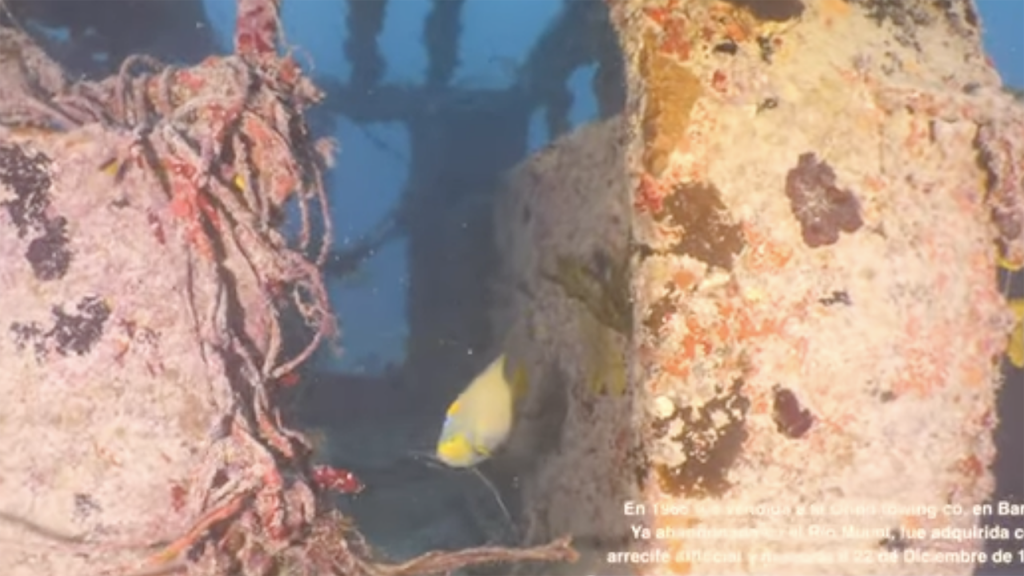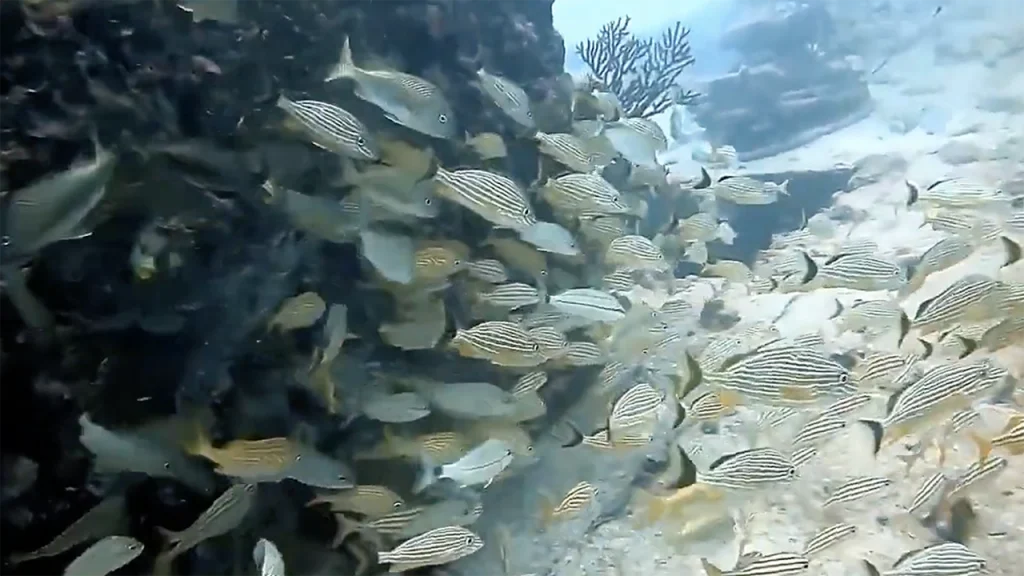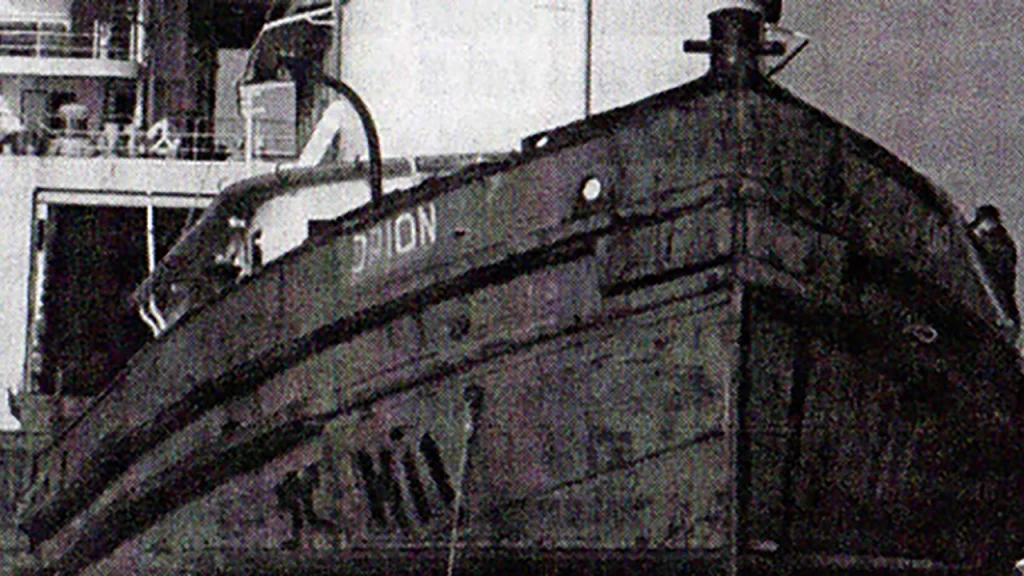Table of Contents

The Orion offers a more intimate, easily accessible diving experience compared to larger, deeper, or more historically significant wrecks in Florida. Its manageable size and depth, combined with abundant marine life, make it an excellent option for advanced divers looking for a rewarding dive without the challenges of extreme depth or currents.
Article at a Glance
- Location and Depth: The Orion wreck is located approximately 5 kilometers (3 miles) off the coast of Key Biscayne, Florida, at an average depth of 95 feet (29 meters) and a maximum depth of 118 feet (35.8 meters).
- Historical Significance: Sunk in 1981 as part of an artificial reef program, the Orion is a steel-hulled tugboat that has become a vibrant underwater ecosystem over the years.
- Unique Features: Divers can observe the wreck’s intact hull structure, a separated wheelhouse from Hurricane Andrew, and significant marine growth, including sponges and corals.
- Marine Life: The wreck is home to diverse marine life, including schools of grunts, groupers, eels, and various invertebrates, making it an excellent site for underwater photography.
- Safety Measures: Key safety protocols include diving in pairs, proper dive planning, equipment requirements, and adherence to depth limitations for advanced divers.
- Diving Experience: The Orion offers a less crowded dive experience compared to larger wrecks, making it ideal for those seeking a more intimate exploration of marine history.
- Dive Shops: Several dive shops in the Miami area, such as Diver’s Paradise Miami and Grove Scuba, provide diving trips to the Orion wreck, allowing divers to explore this unique site.
Shipwreck Location Coordinates and Depth
Depth
The Orion rests at an average depth of about 95 feet (29 meters). However, the maximum depth at the site is reported to be:
Location Coordinates
The Orion wreck is located approximately 5 kilometers (3 miles) off the coast of Key Biscayne, in the southwest corner of the reef. Its precise coordinates are:25° 41.460′ N, 80° 05.180′ W

What Do Scuba Divers Say About This Ship
Overall Experience
Divers generally find the Orion to be an interesting and enjoyable dive site, especially for a shorter second dive. While it’s often overlooked in favor of larger wrecks in the area, it offers a unique experience.
Marine Life
The Orion wreck is known for its abundant marine life:
- Schools of grunts are frequently seen on the deck of the wreck.
- The proximity to coral hard bottom habitat contributes to the diversity of marine life.
- Divers have reported seeing large hermit crabs in queen conch shells on the seafloor.
Wreck Condition
The Orion has been affected by time and natural events:
- The wheelhouse broke off during Hurricane Andrew in 1992 and now lies off the starboard side of the hull.
- Despite the damage, the wreck still provides significant vertical relief, about 15 feet (5 meters) from the seafloor.
Diving Conditions
- Visibility is generally good, ranging from 10 to 30 meters (33 to 98 feet).
- Current is typically limited.
- The wreck is suitable for advanced divers and underwater photography.
Accessibility
- The Orion can only be accessed by boat, located about 5 kilometers (3 miles) off the coast of Key Biscayne.
- It’s often described as a good option for a shorter, second dive of the day.
What Kind of Marine Life Can Be Found on The Ship
Common Sightings
- Schools of grunts: These are frequently seen on the deck of the wreck.
- Groupers: Various species of grouper are known to inhabit the wreck.
Other Marine Life
- Eels: Green moray eels are often spotted in the area.
- Snappers: Schools of snapper are common around Miami’s artificial reefs.
- Barracudas: These predatory fish are frequently seen, especially in winter.
- Angelfish: Various species of angelfish inhabit the wreck.
Invertebrates and Coral Growth
- Sponges: Colorful sponges have grown on the wreck over time.
- Sea fans: These soft corals add to the wreck’s visual appeal.
- Hard and soft corals: Various species have colonized the structure since its sinking.
Occasional Visitors
- Jewfish/Goliath Grouper: These large fish are sometimes spotted around Miami’s wrecks.
- Nurse sharks: These generally harmless sharks may be seen in the vicinity.
- Stingrays: Various species of rays are known to frequent the area.
Key Information
| Category | Details |
|---|---|
| Vessel Type | Steel-hulled tugboat |
| Year Sunk | 1981 |
| Purpose | Artificial reef program |
| Coordinates | 25° 41.460′ N, 80° 05.180′ W |
| Distance from Shore | 5 km (3 miles) off Key Biscayne |
| Average Depth | 95 feet (29 meters) |
| Maximum Depth | 118 feet (35.8 meters) |
| Vertical Relief | 15 feet (5 meters) |
| Original Length | 126 feet |
| Original Beam | 28 feet |
| Visibility Range | 10-30 meters (33-98 feet) |
| Notable Feature | Wheelhouse separated in 1992 (Hurricane Andrew) |
| Recommended Certification | CMAS ** or Advanced Open Water (AOW) |
| Best Known For | Schools of grunts, diverse marine life |
| Typical Dive Profile | Often used as a shorter, second dive of the day |
| Access Method | Boat access only |
What Makes The Orion Wreck a Unique Diving Experience
- Historical significance: The Orion is a steel-hulled tugboat intentionally sunk in 1981 as part of an artificial reef program. This gives divers the opportunity to explore a piece of maritime history.
- Hurricane damage: The wheelhouse broke off during Hurricane Andrew in 1992 and now lies off to one side of the main hull. This adds an intriguing element to the wreck’s structure and layout.
- Established ecosystem: Having been underwater for over 40 years, the Orion has become a well-established artificial reef. It hosts abundant marine life, including schools of grunts often seen on the deck.
- Accessibility: Located about 5 kilometers (3 miles) off the coast of Key Biscayne, the Orion is relatively easy to access by boat.
- Depth profile: With an average depth of 29 meters (95 feet) and a maximum depth of about 36 meters (118 feet), the Orion offers an interesting dive for advanced divers.
- Photographic opportunities: The wreck is suitable for underwater photography, offering both wide-angle shots of the structure and close-ups of marine life and coral growth.
- Less crowded: Often overlooked in favor of larger wrecks in the area, the Orion can provide a more intimate diving experience.
- Ideal for shorter dives: Its size and depth make it perfect for a shorter, second dive of the day.
How Does The Orion Wreck Compare to Other Shipwrecks in Florida
Size and Type
- The Orion is a 126-foot steel-hulled tugboat, making it smaller than many other popular wrecks in Florida.
- For comparison, the Spiegel Grove in Key Largo is 510 feet long, and the USS Oriskany in Pensacola is 911 feet long.
Depth
- The Orion sits at an average depth of 95 feet (29 meters), with a maximum depth of 118 feet (35.8 meters).
- This makes it more accessible than some deeper wrecks, but still challenging enough for advanced divers.
Age and Condition
- Sunk in 1981, the Orion has been underwater for over 40 years, allowing for significant marine growth.
- Its wheelhouse broke off during Hurricane Andrew in 1992, adding an interesting element to its structure.
Marine Life
- The Orion is known for schools of grunts on its deck and diverse marine life due to its proximity to coral hard bottom habitat.
- While impressive, it may not host as large species (like Goliath groupers) as frequently as some larger wrecks.
Accessibility
- Located just 3 miles off Key Biscayne, the Orion is more easily accessible than some remote wrecks.
- It’s often used as a second, shorter dive of the day.
Historical Significance
- While part of an artificial reef program, the Orion lacks the historical significance of wrecks like the USS Oriskany or Spanish galleons.
Popularity
- The Orion is often overlooked in favor of larger, more famous wrecks, potentially offering a less crowded dive experience.

What Historical Features Can Still Be Identified on The Orion Wreck
- Steel hull structure: The Orion was a steel-hulled tugboat, and much of its basic hull structure remains intact underwater.
- Deck area: Schools of grunts are often seen on the deck of the wreck, indicating that portions of the deck are still identifiable.
- Separated wheelhouse: The wheelhouse broke off during Hurricane Andrew in 1992 and now lies off to the starboard side of the main hull. This is a distinctive feature that divers can observe.
- Vertical relief: The wreck provides about 15 feet (5 meters) of vertical relief from the seafloor, giving divers a sense of the vessel’s original dimensions.
- Marine growth: After over 40 years underwater, the wreck is covered in sponges, sea fans, and various coral growths, which have become part of its historical character.
- Hull damage: The wreck is described as “quite battered,” likely due to its long time underwater and the effects of Hurricane Andrew. This damage itself is now part of the wreck’s history.
- Original dimensions: While altered by time and events, the wreck’s overall size (originally 126 feet long with a 28-foot beam) can still be approximated underwater.
What Safety Measures Are in Place for Divers Visiting the Orion Wreck
- Dive site accessibility: The Orion wreck can only be accessed by boat, which allows for controlled access and supervision by dive operators.
- Depth limitations: With an average depth of 95 feet (29 meters) and a maximum depth of 118 feet (35.8 meters), the site is restricted to advanced divers with appropriate certification levels (CMAS ** / AOW recommended).
- Dive planning: Proper dive planning is essential, including calculating air consumption at depth and planning for adequate air reserves.
- Buddy system: Divers are likely required to dive in pairs for added safety.
- Equipment requirements: Divers are expected to have appropriate gear for wreck diving, including:
- Primary and backup dive lights
- Wreck reel and line for navigation
- Cutting devices for entanglement emergencies
- Surface marker buoy (SMB) for surfacing safely
- Limited penetration: Given the Orion’s condition and size, extensive penetration is likely discouraged or prohibited without specialized training.
- Dive briefings: Boat crews typically provide detailed briefings on local conditions, potential hazards, and emergency procedures.
- Current awareness: While currents are typically limited at this site, divers are advised to be aware of potential water movement.
- Marine traffic warnings: Divers are cautioned about the presence of pleasure boats in the area.
- Environmental protection: Divers are likely instructed not to touch or disturb the wreck to preserve its structure and marine life.
- Emergency procedures: Established protocols for out-of-air emergencies, lost diver scenarios, and other potential issues are typically in place.
Dive Shops That Provide Diving Trips to This Shipwreck
- Diver’s Paradise Miami
- Address: 4000 Crandon Blvd, Key Biscayne, FL 33149
- Phone: (305) 361-3483
- Website: https://diversparadise.miami/
- South Beach Divers
- Located in Miami Beach, Florida
- Ocean Safari
- Located in Miami, Florida
- Grove Scuba
- Located in Coconut Grove, Florida
- Austin’s Diving Center
- Located in Miami, Florida





